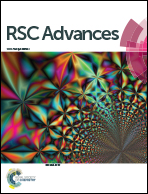In situ synthesis of Bi2S3/Bi2SiO5 heterojunction photocatalysts with enhanced visible light photocatalytic activity†
Abstract
In order to improve the photocatalytic activity of Bi2SiO5 under visible light irradiation, Bi2S3/Bi2SiO5 heterojunctions were synthesized through a facile in situ ion exchange method. Thioacetamide (TAA) is regarded as the appropriate sulfur source. The as-prepared samples of Bi2SiO5 and Bi2S3/Bi2SiO5 were systematically characterized by XRD, SEM-EDS, TEM, XPS, PL, UV-vis DRS and BET techniques. The photocatalytic activities of the samples were evaluated by degrading rhodamine B (RhB) under visible light and UV-vis light irradiation, respectively. Bi2S3/Bi2SiO5 heterojunctions show enhanced photocatalytic activities under visible light irradiation. Further investigation reveals that ion exchange reaction time plays an important role in the photocatalytic efficiency. The mechanism of the enhanced photocatalytic activity was proposed.


 Please wait while we load your content...
Please wait while we load your content...